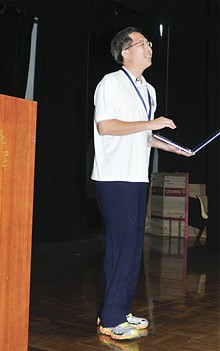The Growing of Tai Chi for Health Institute and Communities
It has being said the heart of the matter is often the matter of the heart, and the best way to get to the matter of the heart is to ask the “why” question. It is important that we answer the “why” question first, before we consider the “what” and “how” questions, because the “what” and “how” questions relate more to the mind. Conventional wisdom tells us that the heart must first be convicted, before the mind can be aligned, so that the action can be consistent.

In the same vein, the Tai Chi for Health Institute (TCHI) need also to ask the question “why do we exist” before we ask “what must we do and how can we grow”. This is a question of our purpose and vision. In this regard, I believe we have an excellent answer. The purpose of TCHI is to empower people to improve their health and wellness and the vision is making Tai Chi for Health accessible to everyone for health and wellness. This is a very laudable purpose and vision indeed, for all of us in TCHI have a common passion to see Tai Chi for health being promoted to all people, so that they can benefit in health and wellness.
In the World Health Organisation definition, there are six dimensions to health and wellness. They are:
2. Intellectual- acquiring knowledge and skills
3. Physical- caring for one’s health
4. Vocational- finding fulfilment through work and volunteerism
5. Emotional- managing and expressing feelings
6. Spiritual- appreciating life, having valuesIndeed, a person can only be truly well if all six dimensions of health and wellness are healthy.
2. Intellectual- learning Tai Chi is acquiring knowledge and skills, the limitless depth of Tai Chi also means that we need life long learning to gain mastery
3. Physical- Tai Chi for health program has been proven to improve one’s health
4. Vocational- volunteering to teach Tai Chi classes brings fulfillment through work and volunteerism
5. Emotional- Tai Chi helps us make friends and calm our emotion and mind, so that we can manage and express our feelings to one another better
6. Spiritual- Tai Chi for health program certainly helps us to appreciate life more, and have values that are more selfless
The keys to unlock this tremendous potential lie in our purpose and vision as well: to empower people to improve health and wellness by making Tai Chi for Health accessible for everyone.
How then can we empower people and make Tai Chi for Health accessible for all? As much as the magic of Tai Chi lies in the Tai Chi principles, I believe the magic of the growth of Tai Chi for Health (TCH) program will depend on the Tai Chi principles as well.

In Tai Chi, the posture should be upright and the weight transfer should be deliberate, and balance, when moving forward or backward. Translated into growing the TCH program, we ought to be upright in our character and values, and also demonstrate empathy in our relationship building. Be careful to listen to one another before we give appropriate comments or advices. Be sensitive to the emotional transference in our communications and dealings, so that we can keep it positive to build up one another.
The third category of Tai Chi principles refers to the “internal”, that of “Jing” and “Song”. Simply translated, “Jing” means to “remain focus in the practice of Tai Chi“ and “Song” means to “open up the joints”. “Jing” can be translated into mindfulness, the purposeful intentional self-awareness that allows us to observe our own perceptions, thoughts, feelings and actions on a moment-to-moment basis, and to understand the internal and external factors contributing our own reactions. “Song” can be translated into openness in our minds and hearts, so that we can accept what is not our own, see the positive in everyone and every situation, so that we can build on the positive in every circumstance.
The TCHI is like the Yin of the TCH movement. In the area of training and education, she can develop curriculum and pedagogy of TCH program and better tools for trainers to teach better. In the area of research, TCHI can collate medical studies that are evidence based, to show the improvement of health and wellness outcomes of the TCH program. She can also develop research protocol and teach research methodology to our members who are keen to do research. In the area of promotion and resource, TCHI can develop marketing strategies and business plans to convince funders of the cost effectiveness of our TCH program, and also help with accreditation of instructors and master trainers.
If we can nurture TCH institute and TCH communities all over the world by relating to one another based on the Tai Chi principles for growth, I am certain that in the not too distant future, we may be able to realise a common dream: “to empower people to improve health and wellness by making Tai Chi for Health accessible for everyone.” We can do it!
